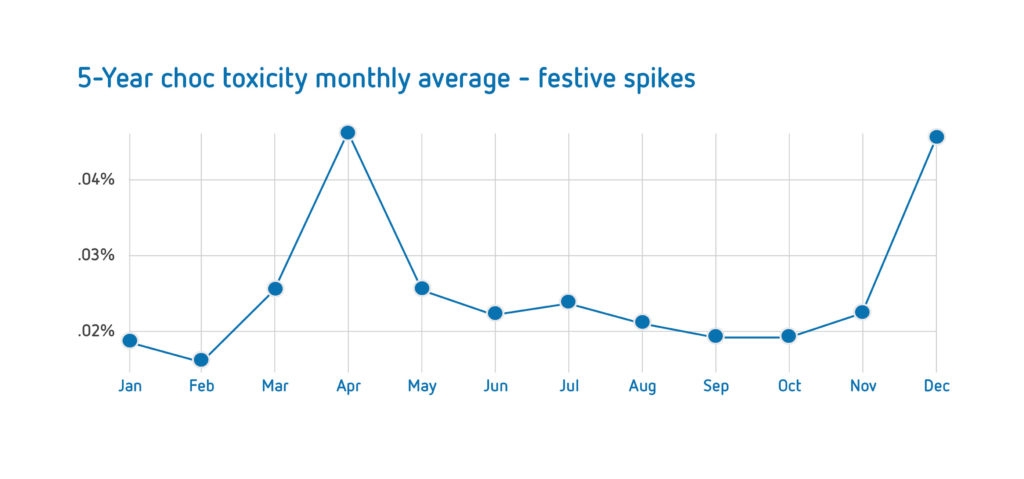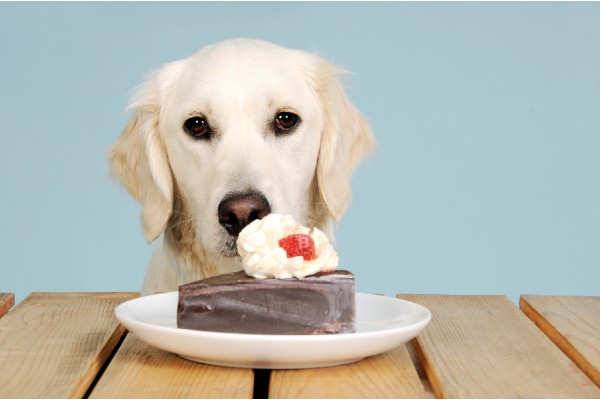As Easter rolls around for another year, it’s not just the dangers of chocolate to our waistlines we should be mindful of, but also the dangers it poses to our furry companions.
Let’s take a look at why chocolate is so dangerous to dogs, other foods that are toxic to pets, and what to do if your dog eats something they shouldn’t have.
Easter mightn’t be a dog’s best friend
As one of Australia’s leading pet insurance administrators, PetSure – who administer Medibank’s pet insurance – know the dangers of dogs eating chocolate all too well. They compiled monthly averages of chocolate poisonings over a five-year period, and it shows Christmas and Easter are responsible for the biggest spike in cases throughout the year.

Source: PetSure
According to PetSure, whilst chocolate is toxic for cats, they’re more cautious and represent significantly fewer incidents.
What happens when my dog eats chocolate?
High sugar concentration in chocolate can upset doggy tummies and the high fat content can cause pancreatitis. But it’s the combination of caffeine and theobromine that can prove most dangerous, elevating heart rates and stimulating the nervous system of dogs.
How much chocolate is toxic to dogs?
That depends on the concentration of theobromine. For example, here’s a list of chocolate types listed in order of theobromine content:
- Cocoa powder (most toxic)
- Unsweetened cooking chocolate
- Semisweet chocolate
- Dark chocolate
- Milk chocolate
Other foods that are toxic to pets
With Easter coming up, it’s natural to focus our attention on chocolate, the festive treat of choice, but there are other foods we should be mindful of too. These include:
- Onions & garlic (and foods containing them)
- Macadamia nuts
- Raisins and grapes
- Foods containing caffeine
- Fatty foods
Be especially cautious of hot cross buns as many of them contain raisins and/or chocolate! Tomatoes are especially dangerous to cats as are lily plants. And avocados are toxic to dogs.
Artificial sweeteners such as Xylitol (found in chewing gum, toothpaste and some baked goods) can trick the dog’s metabolic system into thinking it’s sugar, resulting in low blood sugar, which in turn can lead to seizures and even death.
Even if it’s not edible, it’s important to remember that animals sometimes use smell and taste to investigate any curious objects. So be mindful of Easter decorations that have the potential to be a choking hazard.
What to do if your dog eats chocolate
Firstly, it’s important to know the signs of poisoning. Signs of toxicity include:
- Vomiting
- Diarrhea
- Restlessness
- Increased urination
- Tremors
- Elevated or abnormal heart rate
- Seizures
If you notice any of these warning signs, or suspect your dog has ingested any chocolate, call your veterinarian immediately. It’s always best to respond with the greatest urgency and play it safe from the outset, for the sake of your fur buddy.
How to keep them safe during Easter festivities
Instilling food discipline in your pooch is always a good starting point. Teaching them a “Leave it!” command can be an effective way to curb that insatiable urge to pick up any dropped food.
For us humans, it’s important to put food away from the reach of prying paws at all times. Festive occasions may also bring many people together, some of whom wouldn’t have grown up with animals, let alone understand the dangers of certain foods to them, so it’s worthwhile informing your guests of these dangers.
If an Easter Egg hunt is on the cards, be mindful of all the hiding spots so that you can collect all the unclaimed eggs and prevent any curious doggy tastebuds finding them.
And ensure they’re looked after the best they can
A man’s best friend deserves the best, so provide them with the best care possible. Medibank Dog Insurance offers two levels of cover for your dog’s medical expenses, including the award-winning Ultimate Pet Care, for dogs aged from 8 weeks to 9 years old. Find out more on our Medibank Dog Insurance page.


